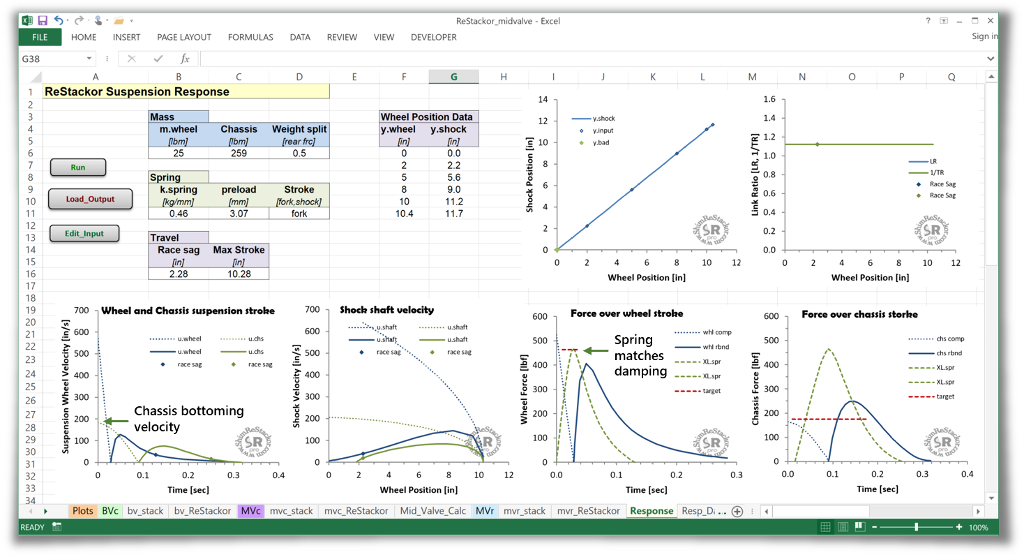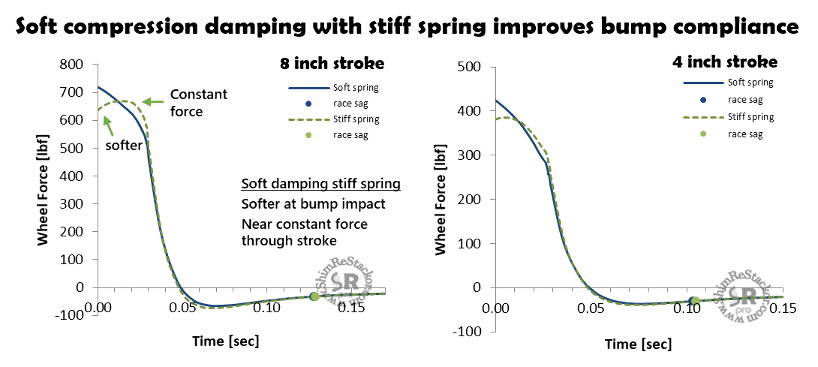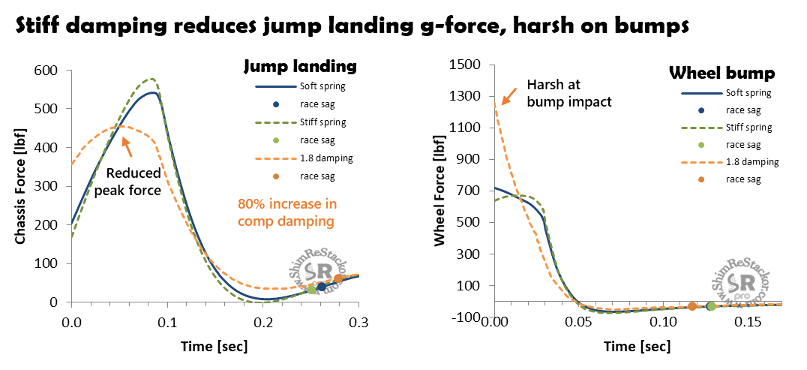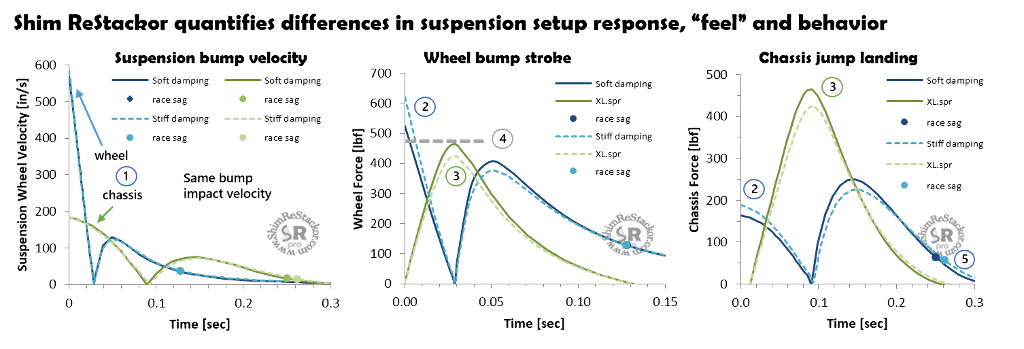There are two ways to stop a suspension from bottoming:
- Stiff springs with soft damping
- Soft springs with stiff damping
What is the difference in suspension performance?

Fork spring rate range
A 180 lbm rider (with 25 lbm gear= 205 lbm) can run fork spring rates from 0.39 to 0.46 kg/mm and hit race sag at 65 mm, measured on the stanchion tube, by changing the fork spring preload from 15 to 3 mm (more).
What is the difference in suspension performance between running a stiff or soft spring?

Stiff spring setup
Compression damping on the stiff 0.46 kg/mm spring was set to match the peak spring force on a ten inch wheel bottoming stroke. Matched peak force gives a plush bottoming stroke. Jjump landings bottom at an impact velocity of 183 in/sec with the stiff spring, equivalent to a 3.6 ft jump height (more).
Rebound damping was set at zeta 0.7 and tuned to give a flat zeta response across the range of stroke depths (more).

Soft spring setup
The softer 0.39 kg/mm spring needs a 15% increase in compression damping to produce the same 183 in/sec jump landing bottoming resistance. On a 10 inch wheel bottoming stroke, the stiffer compression damping produces a 180 lbf increase in damping force at bump impact.
Stiff compression damping at bump impact makes the suspension “feel” harsh.
Rebound damping was tuned to match the softer spring and produce the same zeta 0.7 rebound response across the range of stroke depths.

Soft versus stiff spring suspension performance
The plots below show the suspension force acting on the wheel through the suspension stroke. “Wheel Force” is the sum of spring plus damping force.
Hitting a bump hard enough to bottom the wheels requires a bump velocity of 600 in/sec for both setups. The stiff spring setup produces a peak compression damping force approximately equal to the peak spring force. Matched peak force produces a near constant force through the compression stroke (green line) giving the suspension a consistent “feel”.
The soft spring case (blue line) requires stiffer compression damping to match jump landing bottoming resistance. The stiffer compression damping produces a higher force at bump impact followed by a falloff to the peak spring force at bottoming. On an eight inch wheel bottoming stroke the soft spring/stiff compression damping setup produces a 100 lbf stiffer force at bump impact making the suspension “feel” harsh.

Jump landings
On jump landings, the soft spring with stiff compression damping absorbs more of the ground impact early in the stroke. The soft spring produces less force at the end of stroke reducing the g-force on the rider at bottoming. The soft spring case is plusher on jump landings.
On rebound, the soft spring takes more time to return to race sag making the setup susceptible to packing.

Increasing compression damping by 80% further demonstrates the effect of compression damping on jump landings. Stiff compression damping absorbs the jump landing impact early in the stroke allowing the use of softer springs, which reduces the peak spring force at end of stroke.
Reducing the end of stroke spring force reduces the g-force on the rider making the soft spring case plusher on jump landings.
However, stiff compression damping produces higher forces at bump impact. The 80% increase in compression damping generates a bump impact force of 1250 lbf forcing the chassis to deflect off the bump.
Stiff compression damping reduces the rider jump landing g-force but gives poor suspension compliance on braking bumps or root and rock impacts.

Shim ReStackor suspension response
Suspension response calculations combine damping force, spring and gas force, and rider weight to determine wheel and chassis bottoming velocities and the forces acting on the wheel through the suspension stroke.
A simple plot of spring and damping force acting on the wheel through the suspension stroke gives some insight into suspension “feel” and features of various tuning options.

Stiff spring with soft comp damping
- Same wheel and chassis bottoming velocity
- Softer bump impact force improves suspension compliance
- Stiffer spring force at bottoming increases g-force on rider
- Matched peak force produces a constant force through the stroke giving the suspension a consistent “feel”
- Faster return to race sag reduces packing
The reduced bump impact force and faster return to race sag makes the stiff spring with soft compression damping the better setup for rocks and braking bumps.
Soft spring with stiff comp damping
- Same wheel and chassis bottoming velocity
- Higher force at bump impact makes the setup harsh
- Softer spring force at bottoming reduces jump landing g-force on rider
- Peak force (2) higher than spring force (3) causes chassis to deflect off bumps
- Slow return to race sag increases rebound packing
The reduced rider g-force on jump landings makes the soft spring with stiff compression damping the better setup of MX jump landings, but compromises compliance on braking bump.
Shim ReStackor numerical test bed
Shim ReStackor response calculations provide a numerical test bed for comparison of various tuning options. A simple plot of spring and damping force acting on the wheel through the suspension stroke gives insight into the suspension “feel” and the effect of various tuning options. Understanding those differences allows smart tuning decisions separating the effect of spring rate and damping on suspension “feel” and performance.
Calculations include the effect of compression adjusters, fork base valves, shim stack float, crossovers, spring rate and gas force allowing balancing of the system over the entire range of stroke depths and suspension velocities.

